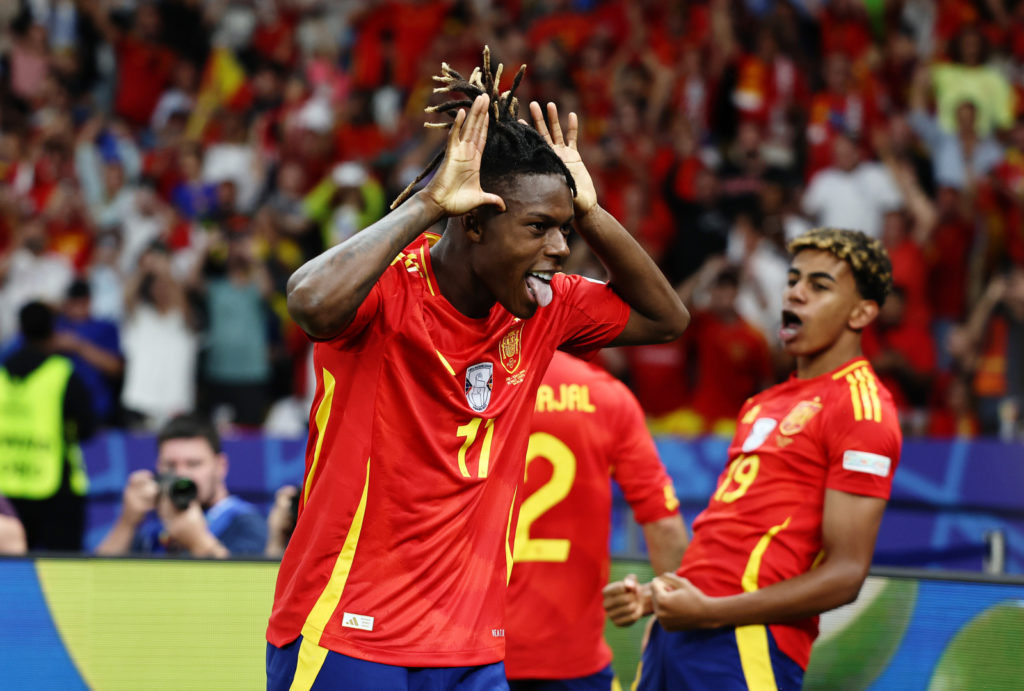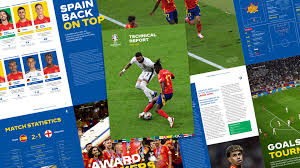September 19 – Spain’s tactical evolution is one of the standout findings from UEFA’s Euro 2024 Technical Report that details tactical trends and developments from the tournament.
The report details that Champions Spain’s approach to wide play has changed since utilising inside-forwards during their 2012 Euro victory, instead opting for wingers Lamine Yamal and Nico Williams who looked to provide genuine width, with defenders struggling to compete with their two-way attacking style.
Statistics show that Williams, particularly effective on the left, consistently threatened defenders and worked closely with full-back Marc Cucurella. Their underlapping runs allowed Spain to vary their attack, either by Williams cutting inside and Cucurella advancing, or Williams staying wide while Cucurella moved centrally.
Speaking to UEFA, Spain Coach De La Fuente said: “Fundamentally, it was about having an idea that we were faithful to. We started working on it over a year and a half ago and it was about sticking to this approach as well as adapting it to the players, in order to develop this style of play. I think that our style was clear to see – it was perfectly executed by the players themselves.

“I’m convinced that football has always been about having good wingers because at the end of the day you’re looking for lots of width and more penetration. Fundamentally, a good winger makes the team more unpredictable because the opposition don’t know how to defend against them, whether to follow the touchline or stop the cross.”
The report uncovers a trend of teams increasingly bypassing pressing opponents by playing long from goal kicks, with the average second pass following a goal kick travelling 47.9 meters.
Slovakia’s win over Belgium is a prime example, as their centre-backs avoided short passes under pressure, opting for direct passes to midfielders and forwards, which allowed them to compete effectively against Belgium’s possession style.
Champions Spain also utilised the passing range of the goalkeeper, creating five goalscoring opportunities directly from goal kicks – more than any other team.
UEFA detail that the Euro Final was a clash of styles, as Spain’s high volume of chance creation met England’s stubborn defence – the report shows Southgate’s side predominantly played in a low block whilst De La Fuente opted to utilise his talent on the wings.
The role of set pieces changed into exclusively a metric for assists, with not a single goal coming by way of a direct free kick.
The tournament also saw long throws become more popular as teams looked to break down the low block. It was Kyle Walker’s long throw which set up Jude Bellingham’s overhead kick, deemed by UEFA to be the second-best goal at the tournament behind Lamine Yamal’s strike versus France.
The report details the importance of substitutes throughout the tournament, as they were responsible for 11 of the 12 goals scored in added time – boosted by the five-substitute rule.
On top of this, the stats show that substitutes contributed to a rise in comeback victories, which increased to ten, up from five in both 2016 and 2021. Mikel Oyarzabal’s winning goal in the final was a fitting example of the trend, as he was one of eight players who scored match-winners after coming off the bench.
Contact the writer of this report, Harry Ewing, at moc.l1745118749labto1745118749ofdlr1745118749owedi1745118749sni@g1745118749niwe.1745118749yrrah1745118749
Sent from my iPad

